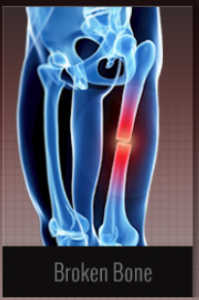San Antonio Serious Injury Lawyer
Fractures are common in car crashes and because of the speeds and the force of the impacts involved, the fractures are often more serious than in falls. Broken legs are often serious and can impact a victim’s life because they are load bearing.
Traction treatment has been used for serious leg fractures for decades
Serious fractures sustained in automobile wrecks are more likely to require surgery, and in some cases our experienced San Antonio car accident injury attorneys see multiple fractures requiring reconstructive surgery and crush injuries in which metal hardware may be needed to secure bones. 
Because of the complicated nature of leg fractures it’s almost always worth contacting a Texas serious injury lawyer. The victim may require intensive surgery or long periods of physical therapy. Insurance companies may seek to short change the victims in a settlement that fails to cover all costs.
Although a leg injury hopefully will not involve the same kind of long-term financial and physical costs as a traumatic brain injury or a spinal injury, fractures often do attract sizeable figures in settlements.
Serious broken bone injuries such as legs, pelvis and skull fractures can result in six figure settlements.
It’s usually fairly obvious if you have broken a bone in an accident. Symptoms include a misshapen limb or joint, swelling, intense pain and limited mobility.
If you suffer a fracture you should seek medical care immediately.
There are many bones in the leg. The femur is the single bone, also known as the thigh bone, in the upper leg. It requires a great deal of force to break a thighbone across its length and this fracture is often associated with potentially life-threatening injuries to other parts of the body. 
The lower leg has two bones, the tibia and the fibula. The knee joins the thigh to the lower leg. There are many small bones in the ankle. The foot contains five bones called the metatarsal bones that join the ankles to the toes. The toes are formed by small bones called phalanges.
A sprain is a tear of the ligaments that hold the bones together. Severe sprains and fractures need surgery to repair. But in less severe case they may heal themselves.

A leg may need to be immobilized and kept in one position in a splint or a cast for a time to heal. In some cases this can mean a victim of a crash is unable to work and may lose out financially. A leg may need to be kept above heart level to decrease the risk of swelling. Patients who are not allowed to put weight on a leg will be given crutches. Muscles can be become smaller due to the lack of exercise in a period of immobilization. This is known as atrophy. Please see this website
There are some dangers of side effects after a fracture. If a cast is fitted too tightly it can cause nerve damage, paralysis and a loss of sensation. Patients should inform their doctor of any feeling of numbness or tingling.
You could lose a limb if circulation is cut off to a leg. In rare cases blood clots can be dislodged from the leg and enter the lungs where they can prove to be fatal.
Tragically there are cases in which a broken leg has led to complications that have claimed a victim’s life.
The Houston Chronicle recently reported the case of Michael Guigliano who fractured his left leg when he fell 15 feet at work. He was admitted to a local hospital but developed fat embolism syndrome, a complication associated with orthopedic surgeries. His family claimed a series of mistakes at the hospital led Mr. Guigliano to leave the hospital as a severely brain damaged quadriplegic.
He died a few years later. The family sued the hospital and received an undisclosed sum.
TYPES OF LEG FRACTURE
Closed (simple) fractures – where the skin is intact
Open (compound) fractures – where bones that break the skin. These breaks carry a greater risk of infection.
Complete fracture – where bone fragments separate completely.
Incomplete fracture – where bone fragments are still partially joined.
Linear fracture – A break parallel to the bone’s long axis.
Oblique fracture – A fracture that is diagonal to a bone’s long axis.
Transverse fracture – A fracture at right angles to the bone’s long axis.
Spiral fracture – A break in which at least one part of a bone has been twisted.
Comminuted fracture – where a bone has broken into a number of pieces.
Impacted fracture – a break caused when bone fragments have smashed into each other.
For more information